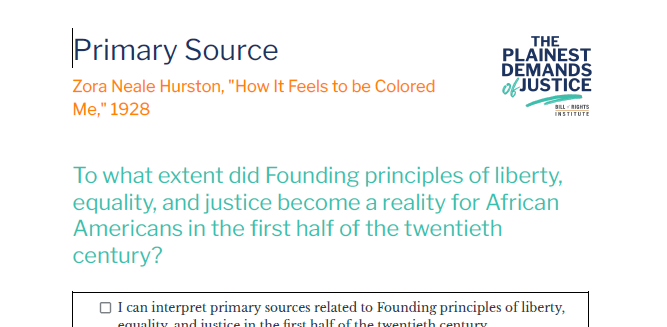Zora Neale Hurston, “How It Feels to be Colored Me,” 1928
Guiding Question: To what extent did Founding principles of liberty, equality, and justice become a reality for African Americans in the first half of the twentieth century?
- I can interpret primary sources related to Founding principles of liberty, equality, and justice in the first half of the twentieth century.
- I can explain how laws and policy, courts, and individuals and groups contributed to or pushed back against the quest for liberty, equality, and justice for African Americans.
- I can create an argument using evidence from primary sources.
- I can analyze issues in history to help find solutions to present-day challenges.
Building Context
Zora Neale Hurston was a celebrated author and anthropologist who grew up in the all-Black town of Eatonville, Florida. After her mother’s death, Hurston moved to Jacksonville, a segregated Florida town. It was then, she writes, that “I was not Zora of Orange County any more, I was a little colored girl.” In 1925, Hurston received a scholarship to Barnard College in New York City. While in the city, she befriended other writers such as Langston Hughes and became an artist of the Harlem Renaissance. Hurston’s work focused on Black culture and Black Americans in the South. In this essay, she explores her discovery of her identity as a Black American and celebrates her self-pride.
Zora Neale Hurston, “How It Feels to be Colored Me,” 1928
. . . I am not tragically colored. There is no great sorrow dammed up in my soul, nor lurking behind my eyes. I do not mind at all. I do not belong to the sobbing school of Negrohood who hold that nature somehow has given them a lowdown dirty deal and whose feelings are all but about it. Even in the helter-skelter skirmish that is my life, I have seen that the world is to the strong regardless of a little pigmentation more or less. No, I do not weep at the world—I am too busy sharpening my oyster knife. . . .
At certain times I have no race, I am me. When I set my hat at a certain angle and saunter down Seventh Avenue, Harlem City, feeling as snooty as the lions in front of the Forty-Second Street Library, for instance. . . . I belong to no race nor time. I am the eternal feminine with its string of beads.
I have no separate feeling about being an American citizen and colored. I am merely a fragment of the Great Soul that surges within the boundaries. My country, right or wrong.
Sometimes, I feel discriminated against, but it does not make me angry. It merely astonishes me. How can any deny themselves the pleasure of my company? It’s beyond me.
Comprehension and Analysis Questions
- What does Hurston mean by saying she is not “tragically colored”?
- What is Hurston’s attitude toward race, based on her writing in this excerpt?
- How does Hurston build on Hughes’ views in “The Negro Artist and the Racial Mountain”?

